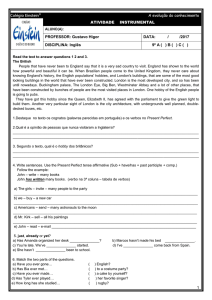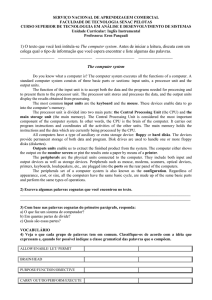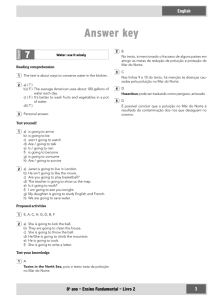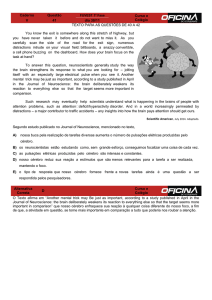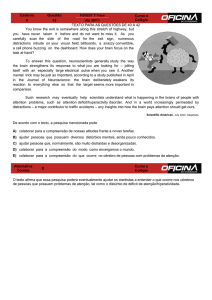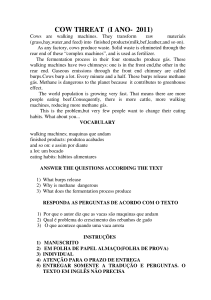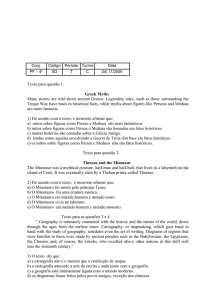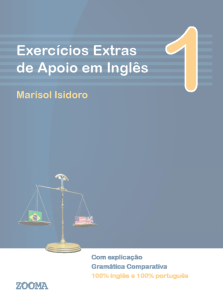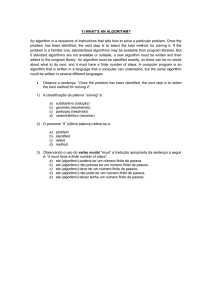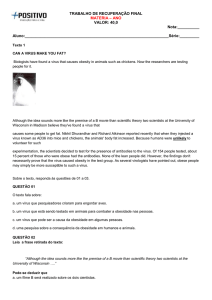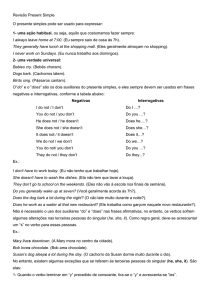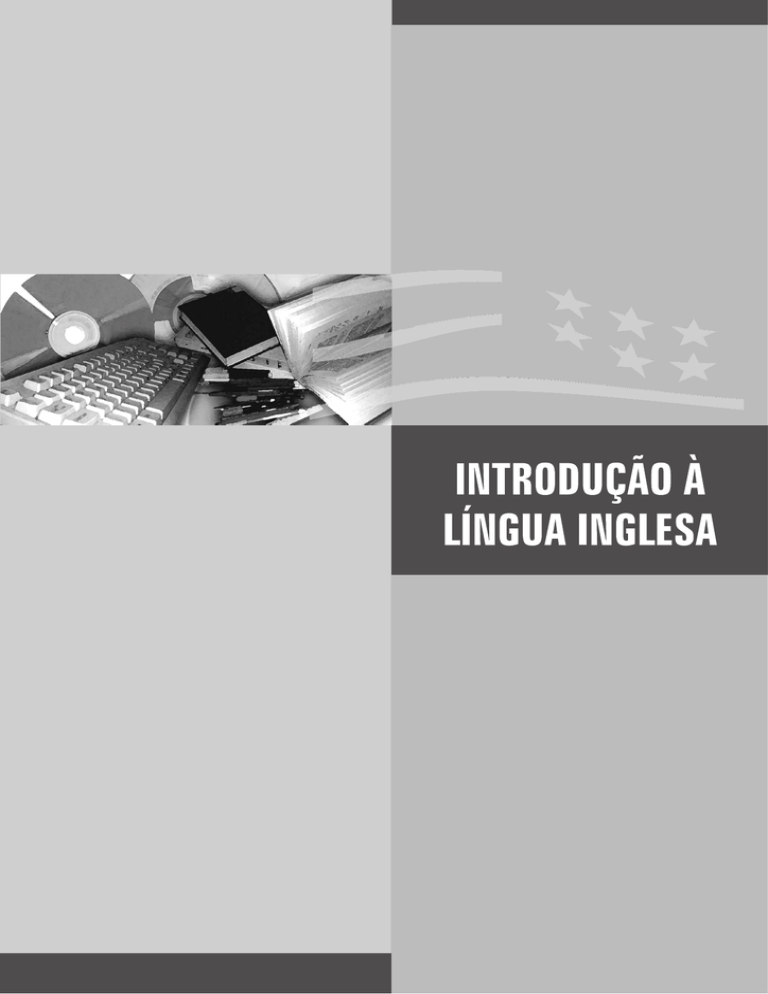
SUMÁRIO DA DISCIPLINA
Plano da Disciplina ...................................................................................................................................... 14
UNIDADE I
CONSCIENTIZAÇÃO
Texto 1: Comparing Different Types of Texts .................................................................................................... 17
Texto 2: Dicas Tipográficas ......................................................................................................................... 18
Texto 3: Pronomes Pessoais e Possessivos ................................................................................................... 18
Texto 4: Marcadores de Substantivo ........................................................................................................... 21
Texto 5: Formação de Palavras (Afixos) ..................................................................................................... 22
UNIDADE II
ASPECTOS LINGUÍSTICOS
Texto 6: Verbos I: To Be, Simple Present, Present Continuous, Past Continuous, Imperative ................... 24
Texto 7: Verbos II: Simple Past Tense ........................................................................................................ 28
Texto 8: Verbos III: Simple Future Tense ................................................................................................... 31
Texto 9: Verbos IV: Modal Verbs ................................................................................................................ 32
Referências bibliográficas ........................................................................................................................... 39
14
Plano da Disciplina
Carga Horária Total: 30h/atividades
Créditos: 02
Relevância da Disciplina
Vários são os fatores que justificam a introdução do ensino da Língua Inglesa: a formação do cidadão,
que através da aprendizagem de diferentes culturas torna-se mais capaz de compreender não só a própria
cultura, mas a pluralidade do patrimônio sociocultural de outras nações, o desenvolvimento da capacidade
de interação do cidadão com o mundo globalizado, o desenvolvimento de um outro olhar sobre a língua
materna, bem como a possibilidade de acesso a diferentes fontes de informação e recursos tecnológicos
– fundamentais para a inserção no mundo acadêmico – são alguns dos benefícios proporcionados pela
aprendizagem de língua estrangeira.
Objetivos da Disciplina
Desenvolver a habilidade de leitura sem deixar de nos preocupar com o processo de aprendizado, pois estamos interessados em como nossos alunos adquirem as competências necessárias para ler e interpretar textos
adequadamente.
Tornar o aluno apto a ler e a entender os textos em inglês de variadas áreas por meio de estratégias e técnicas
de leitura, além de aumentar o vocabulário e estudar a gramática essencial para a compreensão textual.
UNIDADE I: Conscientização
Tempo estimado de autoestudo nesta unidade: 8 h/atividades
Objetivos:
• Conscientizar o leitor das estratégias de leitura que ele inconscientemente já utiliza na leitura de um texto:
conhecimento anterior, dedução, associação etc.;
• Comparar diferentes tipos de textos observando o layout, a fonte etc.;
• Compreender textos de instruções e classificados de jornais;
• Compreender e utilizar palavras que indicam sequência;
• Praticar estratégias de leitura: skimming, scanning, prediction etc.;
• Reconhecer sufixos e prefixos.
Orientação:
Para cursar essa disciplina, além deste material instrucional, você poderá adquirir, se achar necessário, os
seguintes livros:
GUANDALINI, Eiter Otávio. Técnicas de Leitura em inglês: estágio 1. São Paulo: Textonovo, 2002.
SWAN, Michael & WALTER, Catherine. The Good Grammar Book. New York: Oxford, 2001.
Os referidos livros reúnem todos os textos e exercícios indicados e também servirão de base para as avaliações.
Quadro-resumo da unidade
Assuntos
Onde Encontrar
Texto 1: Comparing different types of texts
Página 17
Texto 2: Dicas tipográficas
Página 18
Texto 3: Pronomes Pessoais e Possessivos
Página 18
Texto 4: Marcadores de substantivo
Página 21
Texto 5: Formação de palavras (afixos)
Página 22
Atividades Complementares
Filmes Indicados
1.Shakespeare in Love
2. Braveheart
Sites Indicados
www.speakup.com.br
www.cambridge.org.br
www.intratext.com
www.literature.org
www.britishcouncil.org.br/elt
www.rj.senac.br/idiomas
UNIDADE II: Aspectos Linguísticos
Tempo estimado de autoestudo nesta unidade: 8h/atividades
Objetivos:
• Identificar o sujeito, verbo e objeto na frase;
• Reconhecer os tempos verbais;
• Reconhecer noun groups;
• Compreender textos descritos.
Quadro-resumo da unidade
Assuntos
Onde Encontrar
Texto 6: Verbos I: To Be, Presente Contínuo, Passado Contínuo,
Imperativo, Presente
Página 24
Texto 7: Verbos II: Simple Past Tense
Página 28
Texto 8: Verbos III: Simple Future Tense
Página 31
Texto 9: Verbos IV: Modal Verbs
Página 32
Atividades Complementares
Filmes Indicados
1. Sense and Sensibility
2. The Age of Innocence
15
UNIDADE I
17
CONSCIENTIZAÇÃO
Introdução
O material é apresentado de forma integrada. Cada
unidade tem um texto para ser lido, desfrutado, estudado e analisado de várias perspectivas.
Primeiramente, cada texto traz um tema atual e universal que leva ao desenvolvimento do pensamento
crítico por meio de exercícios que trabalham os três
níveis de compreensão do leitor: nível literal, nível
inferencial e nível apreciativo.
Segundo, pode-se notar que o vocabulário é trabalhado por intermédio de glossários e contextos que
facilitam a compreensão e aquisição dos mesmos.
Em terceiro lugar, este material não deixa de lado a
gramática, trabalhando-a dentro dos paradigmas linguísticos estruturalista e pragmático. As atividades sugeridas
pretendem desenvolver a consciência metalinguística
mediante exercícios que levam ao aprendizado de estruturas em contextos oracionais e textuais. Agregam-se a
isso as informações referentes às categorias gramaticais
estudadas em cada unidade.
Texto 1: Comparing Different Types of Texts
Ler é um ato intelectual complexo. Essa complexidade aumenta ainda mais quando estamos lendo num
idioma diferente do nosso. Para facilitar o nosso trabalho nesta unidade, solicito bastante atenção às estratégias de leitura que indicamos a seguir.
Selectivity – leitura seletiva, isto é, selecionar os
trechos onde se quer encontrar uma determinada
informação (parágrafos, por exemplo).
Palavras-chave:
Inferência – ação ou efeito de inferir; indução, conclusão.
English is an international language. It is very important
in many situations, such as communication, business,
science and tourism. It is essential in education as many
books in some careers ( Medicine, for example ) are
in English. It is also present in our everyday language:
cheeseburger, jeans, laptop, video game, etc.
Estratégias de Leitura
Prediction – significa inferir o conteúdo de um texto
através de seu conhecimento prévio sobre o tema
(background); através do contexto semântico (palavras de
um mesmo grupo, por exemplo: hospital, nurse, doctor,
ambulance); contexto linguístico (pistas gramaticais);
contexto não-linguístico (gravuras, gráficos, tabelas,
números etc.); conhecimento sobre a estrutura do texto
(layout, título, subtítulo, divisão de parágrafos etc.)
Cognates – são palavras de origem grega ou latina
bem parecidas com as do português. Ex.: different – diferente, infection – infecção.
Obs.: Atenção com os falsos cognatos. Ex: “pretend” não significa pretender, mas sim “fingir”; é importante observar se a palavra se encaixa no contexto.
Repeated words – se uma palavra aparece várias
vezes no texto, isto significa que ela é importante para
a compreensão do mesmo.
Typographical evidences – são símbolos, letras maiúsculas, negrito, itálico etc., que são dicas úteis sobre o texto.
Dictionary – o dicionário deve ser utilizado como
último recurso para se descobrir o significado de uma
palavra ou expressão desconhecida.
Skimming – leitura rápida para ter-se uma ideia
central do texto.
Scanning – leitura com o objetivo de encontrar algumas informações específicas no texto.
Text: English All Over The World
Everybody all over the world speaks English. People in
many countries study English because they want to have
success in their professional future. English affects the
entire globe. It influences TV programmes, newspapers,
computer language, etc. And we can find English in
songs and films. They are famous everywhere.
Vocabulary
Business – negócios
Newspaper – jornais
1) Sublinhe as palavras cognatas no texto:
2) Utilizando a técnica skimming, diga qual o assunto do texto?
Textos Complementares
880 milhões de analfabetos (página 14)
The Organized Phone (página 15)
Fonte: GUANDALINI, Eiter Otávio. Técnicas de leitura em inglês: ESP – English for Specific Purposes:
estágio 1. São Paulo: Textonovo, 2002.
18
Texto 2: Dicas Tipográficas
Introdução
Vocabulário
As marcas tipográficas são elementos que, no texto,
transmitem informações nem sempre representadas
por palavras. O aspecto visual, as ilustrações, o tipo
de letra usado, as aspas, os números etc, ajudam-nos
a descobrir muito sobre o conteúdo do texto.
Palavras-chave:
Tipografia – Arte de imprimir com tipos;
estabelecimento tipográfico.
Text: Energy from the sun
Almost all our energy originally came from the
sun. At the Sun’s centre, nuclear reactions give
enormous amounts of energy which radiate from
the surface as heat and light. There is enough
nuclear energy left in the Sun to keep it shinning
for another 5,000 million years. On average, each
square meter of Earth’s surface receives the same
energy from the Sun as it would do from a one-bar
electric fire.
Sun – sol
Earth – Terra
Surface – superfície
Fire – fogo
On average – na medida que
Shine – brilhar
Reading Strategies
1) Circule as palavras cognatas no texto.
2) Utilizando a estratégia “skimming”, responda:
a) Qual é o tema do texto?
3) Utilizando a estratégia “scanning”, responda:
a) Qual é a causa do calor e da luz que recebemos
na Terra?
Indicação de Textos
Antibacterial Soft Scrub (página 18)
Stress Relief (página 19)
Introducing the first multivitamin that gets to the
heart of good health (página 20, 21)
Fonte: GUANDALINI, Eiter Otávio. Técnicas
de leitura em inglês: ESP – English for Specific
Purposes: estágio 1. São Paulo: Textonovo, 2002.
Texto 3: Pronomes Pessoais e Possessivos
Introdução
Em inglês, todo verbo pede um sujeito expresso.
Não se admite sujeito oculto, salvo em raríssimas exceções e em linguagem muito informal.
Leia com bastante atenção o material indicado e, em
caso de dúvidas, consulte o seu monitor.
Personal Pronouns
Possessive
Subjective
I
You
He
She
It
We
You
They
Adjective
my (meu, minha)
your (seu, sua)
his (dele)
her (dela)
its (dele, dela)
our (nosso(as))
your (seus, suas)
their (deles, delas)
Objective
me (me)
you (te,ti)
him (lhe, o)
her (lhe, a)
it (lhe, o, a)
us (nos)
you (vos)
them (lhes, os, as)
Pronouns
mine
yours
his
hers
its
ours
yours
theirs
Reflexive Pronouns
Myself
Yourself
Himself
Herself
Itself
Ourselves
Yourselves
Themselves
Subjective Pronouns
Examples:
This magazine is on computing.
It is on computing.
This is Mrs. Brown. I know her.
Objective Pronouns
Peter and I are here. You can talk to us.
Possessive Adjectives
(precede o substantivo)
Paper tape has its disadvantages.
Reflexive Pronouns
The system itself is very complex. (função enfática)
I hurt myself with a sharp blade. (função reflexiva)
My children go to school by themselves. (função
idiomática)
This is your address. It’s yours.
Indicação
Veja explicação nas páginas 23 e 24, do livro de Eiter Otávio Guandalini, Técnicas de leitura em inglês:
ESP – English for Specific Purposes: estágio 1, editora Textonovo, de 2002.
Text: Crazy Love
I met her when I was 16. A common “friend”
introduced us. Did she like me? Yes, she did. Did
I like her? No, I didn’t like her. I loved her. It was
passion, love at first sight. She really drove me crazy.
And I didn’t know how to live without her.
But the world didn’t want that love. My parents
didn’t approve of it, so I had to see her secretly. And
when that became impossible, I didn’t know what to
do. I wanted her, I needed her, so when I didn’t have
her, things really got out of control. I wrecked the
car, I broke all the doors and windows in my room,
I almost killed my sister. Why did I do that? I had a
passion for her, I went crazy when I didn’t have her.
Today I’m 45. I’m a terminally ill patient in a
hospital, and I know I’m going to die pretty soon.
There’s no one around me now: no family, no friends
and of course she’s not here now.
Did I tell you her name? Cocaine.
I owe her my love, my life, my destruction and my
death.
Freddie Mercury
crazy - louco
introduced - apresentou
met – past tense of meet = encontrou
passion - paixão
1) Sublinhe as palavras cognatas no texto:
2) Responda em português de acordo com o texto:
1. O depoimento acima foi supostamente escrito por
um famoso astro do rock. Qual é o nome dele?
_________________________________________
__________________________________________
__________________________________________
Possessive Pronouns
(substitui o substantivo)
Vocabulary
drove me crazy - me deixava louco
ill - doente
parents - pais
cocaine - cocaína
death - morte
2. Independentemente da real identidade do autor do
relato, identifique alguns dados sobre ele no momento
em que escreveu o depoimento:
a) Qual era a sua idade? ______________________
b) Onde ele estava? _________________________
__________________________________________
__________________________________________
__________________________________________
c) O que ia acontecer em breve? Por quê?
_________________________________________
__________________________________________
__________________________________________
__________________________________________
__________________________________________
d) Quem estava com ele?
_________________________________________
__________________________________________
__________________________________________
e) Com que idade o autor conheceu o grande amor
de sua vida?
_________________________________________
__________________________________________
__________________________________________
f) De acordo com o depoimento, na ausência da
“amada” as coisas ficavam fora de controle. Encontre
no texto 3 fatos que exemplificam essa falta de controle. Copie em inglês:
_________________________________________
__________________________________________
__________________________________________
__________________________________________
__________________________________________
__________________________________________
19
20
g) A identidade da “amada” é revelada apenas no
fim do texto. Afinal, a que se referem os pronomes
she e her usados ao longo do texto? Que efeito a revelação dessa identidade provoca no leitor? Por quê?
_________________________________________
__________________________________________
__________________________________________
__________________________________________
__________________________________________
__________________________________________
Gabarito
1) Freddie Mercury
2)
a) 45 anos.
b) No hospital.
c) Ele iria morrer por causa das drogas.
d) Ninguém.
e) 16 anos.
h) Por que a palavra friend está entre aspas no início
do texto?
_________________________________________
__________________________________________
i) Retire do texto uma frase em inglês em que o autor se dirige diretamente ao leitor:
_________________________________________
__________________________________________
__________________________________________
f)
He wrecked the car.
He broke all the doors and windows in his room.
He almost killed his sister.
g) Referem-se à cocaína. Causa surpresa no leitor ao
saber que a amada era a cocaína.
h) Porque um amigo verdadeiro não oferece drogas.
i) Did I tell you her name?
Exercises
1 Substitute the words in bold type. Use PERSONAL PRONOUNS.
a) The analyst is talking to the operator.
b) The boys are sending the reports.
c) Sheila and I are secretaries.
d) This is my document. Give it to Mr. Green.
2) Choose the correct alternative:
a) Among the four of (we – us) candidates, only one will be selected.
b) Punctuality is practiced by Phil and (I – me)
c) Edmund and (I – me) are operators.
3) Use POSSESSIVE ADJECTIVES.
a) Jim can send _____ curriculum vitae.
b) I have _____ duties here in ____ office.
c) Lana and I are teachers; ____ students are doing ____ tests.
d) Paper tape has ____ disadvantages.
4) Fill the spaces with POSSESSIVES:
a) He’s a programmer. _____ job is to determine objectives of the project.
b) This machine calculates Mrs. Smith’s wages. It calculates ____ wages. I calculate _____.
5) Fill in the blanks with reflexive, emphasizing or idiomatic pronouns:
a) The system _________ is very complex.
b) I hurt _______ with a knife.
c) My children go to school by ___________.
d) The manager __________ answers the phone.
e) We always enjoy __________ at parties.
Gabarito
1) a) He / him
b) They / them
c) We
d) It / him
2) a) us
b) me
c) I
3) a) his
b) my
c) our / our
d) its
4) a) His
b) her / mine
5) a) itself
b) myself
c) themselves
d) himself
e) ourselves
Texto 4: Marcadores de Substantivo
Introdução
Substantivo é a palavra que designa pessoa, lugar, objeto, evento, substância ou qualidade. Os marcadores de
substantivo podem ser: artigos, pronomes possessivos
adjetivos, números cardinais, pronomes demonstrativos.
Indefinite Article (A – An)
A – usamos antes de som consonantal.
A
computer
printer
high-level language
user
European device
An
hour
analog computer
environment
eraser
apple
Marcadores de Substantivo
Demonstrative Pronouns
Singular
This (este, esta, isto)
That (aquele, aquela, aquilo)
Plural
These (estes, estas)
Those (aqueles, aquelas)
Definite Article THE (o, a, os, as)
This is a book and a dictionary; the book is on computing.
I study computer languages but the COBOL language
is not easy.
Indicação
Leia com atenção as explicações nas páginas 29 e 30 do livro Técnicas de leitura em inglês: ESP – English for
Specific Purposes: estágio 1, do autor Eiter Otávio Guandalini, editora Textonovo, ano 2002.
Exercises
1) Use this, that, these or those:
a) ________ is a computer. (este)
b) ________ are computers. (estes)
c) ________ is a printer. (aquele)
d) ________ are printers. (aquelas)
2) Inser a or an:
a) ___ envelope
b) ___ car
c) ___ telephone
d) ___ umbrella
e) ___ secretary
3) Use a / an or the:
a) ____ book on the table is mine.
b) I need ____ book.
c) Give me _____ English book, please.
d) I need ___ pen.
21
22
Gabarito
1) a) This
2) a) an
3) a) The
b) These
b) a
b) a
c) That
c) a
c) the
d) Those
d) an
d) a
e) a
Texto 5: Formação de Palavras (Afixos)
Introdução
Algumas palavras que aparecem nos textos demandam um pouco mais de atenção para inferi-las e reconhecê-las durante a leitura. São as chamadas palavras
derivadas, ou seja, palavras que apresentam componentes denominados genericamente de afixos – que
podem ser prefixos ou sufixos. O conhecimento da
formação das palavras é muito útil, sem dúvida, para
sua compreensão. Isto significa que é necessário reconhecer os afixos mais comumente usados na língua
que se quer aprender e, naturalmente, seu significado.
Palavras-chave
Carefully – cuidadosamente
Childhood – infância
Development – desenvolvimento
Disagree – discordar
Downward – para baixo
Freshmen – calouro
Misunderstand – entender errado
Nonsense – sem sentido
Overdone – exceder
Uncommon – não comum
Formação de Palavras
Prefixação – o prefixo muda o significado da palavra primitiva mas não muda a classe gramatical.
a (sem) - amoral
anti (contra) - anti-nuclear
dis (oposto) - disagree
il, ir, im, in, (não) - illegal
mis (errado) - misunderstand
non (não) - nonsense
un (não) - uncommon
over (excesso, além) - overdone
pre (antes) - prefix
Sufixação – o sufixo pode mudar a classe gramatical da palavra sem mudar-lhe o sentido primitivo.
Formação dos verbos:
-en
freshen
-ify
simplify
-ize
centralize
Formação de advérbios:
-ly (-mente)
carefully
-ward (em direção) downward
Formação de substantivos:
-ance/-ence tolerance preference
-er / -or
trainer
actor
-ee
trainee
-ist
scientist
-ion
education
-ment
development
-ity
sincerity
-ism
modernism
-ness
happiness
-dom
freedom
-hood
childhood
- ship
friendship
Formação de adjetivos:
-able, -ible
desirable
admirable
-an, -ian
American
Sagittarian
-ful
powerful
-y
healthy
-ic
poetic
-ical/-al
sociological magical
-less
homeless
Indicação de Texto
Veja a lista de prefixos e sufixos mais comuns na língua inglesa nas páginas 37, 38 e 39, do livro Técnicas de
leitura em inglês, de Eiter Otávio Guandalini.
Leia o texto “An Equal-Opportunity Tragedy” e faça os exercícios, dando ênfase a quando usar esses tempos verbais.
Filmes Indicados
23
1. Shakespeare in Love
Shakespeare (Joseph Fiennes) sofre um bloqueio que o impede de escrever sua mais nova peça, uma história
de amor com fim trágico. Tudo muda quando ele se apaixona por Lady Viola (Gwyneth Paltrow) e passa a
utilizar suas tentativas de seduzí-la como inspiração.
2. Braveheart
No século XIII, soldados ingleses matam mulher do escocês William Wallace (Mel Gibson), bem na sua noite de
núpcias. Ele resolve então liderar seu povo numa vingança pessoal que acaba deflagrando violenta luta pela liberdade.
Autoavaliação
Leia o texto “We plan to use our spare time...” (páginas 46, 47 e 48), do livro Técnicas de leitura em inglês:
ESP – English for Specific Purposes: estágio 1, do autor Eiter Otávio Guandalini, editora Textonovo, 2002.
Who can get AIDS?
AIDS is an equal opportunity disease. It is caused by HIV (Human Immunodeficiency Virus). AIDS can infect
anyone who has vaginal, anal, or oral sex without using a condom. It can infect anyone who shares an HIV
drug needle. Whoever you are, whatever your age, race, or sex – if you have sex without condoms, or share
needles, you can get aids.
1) Utilizando a estratégia “scanning”, encontre no texto as seguintes informações:
a) Por que a AIDS é considerada uma doença de oportunidades iguais?
b) A única maneira 100% segura de não adquirir AIDS.
24
UNIDADE II
ASPECTOS LINGUÍSTICOS
Introdução
Nesta unidade, estudaremos o verbo to Be, Presente Contínuo, Passado Contínuo, Imperativo, Presente,
dando ênfase a quando usar esses tempos verbais.
Texto 6 – Verbos I: To Be, Simple Present, Present
Continuous, Past Continuous, Imperative
Verb To Be (Present Tense) – Ser ou Estar
Abbreviation
* Usamos o pronome it quando nos referimos a coisas ou animais.
Negative form
I am not
I’m not
You are not You’re not You aren’t
He is not
He’s not
He isn’t
She is not
She’s not
She isn’t
It is not
It’s not
It isn’t
We are not We’re not We aren’t
You are not You’re not You aren’t
They are not They’re not They aren’t
Interrogative form
Am I?
Are you?
Is he?
Is she?
Is it?
Are we?
Are you?
Are they?
Verb To Be (Past Tense)
Affirmative form
I was
(eu era, eu estava)
You were
(você era, você estava)
He was
(ele era, ele estava)
She was
(ela era, ela estava)
It was
(ele/ela era, ele/ela estava)
We were
(nós erámos, nós estávamos)
You were
(vocês eram, vocês estavam)
They were (eles/elas eram, eles/elas estavam)
Negative form
I was not
You were not
He was not
She was not
It was not
We were not
You were not
They were not
I wasn’t
You weren’t
He wasn’t
She wasn’t
It wasn’t
We weren’t
You weren’t
They weren’t
Interrogative form
Was I?
Were you?
Was he?
Was she?
Was it?
Were we?
Were you?
Were they?
Simple Present Tense
Formação: verbo no infinitivo sem to. A 3ª pessoa
do singular recebe –s ou –es:
I walk
You walk
He walks
She walks
It walks
We walk
You walk
They walk
O Simple Present Tense é usado para expressar
ações habituais. É geralmente empregado com advérbios de tempo: always, often, usually, frequently,
sometimes, never, every day, on Mondays etc.
Example: He works every day.
I usually walk to school.
Para formar a 3ª pessoa do singular de alguns verbos
acrescenta-se –s:
Example: walk – walks
Se o verbo terminar em –ss, –sh, –ch, –x, –z ou –o,
acrescenta-se –es:
Example: kiss – kisses
fix – fixes
Se o verbo terminar em –y precedido de consoante,
troca-se o –y por –i e acrescenta-se –es:
Example: try – tries
hurry – hurries
Se o verbo terminar em –y precedido de vogal, segue-se a regra geral:
Example: play – plays
Exceção: verb to have (verbo Ter)
I HAVE
YOU HAVE
HE HAS
SHE HAS
IT HAS
WE HAVE
YOU HAVE
THEY HAVE
Affirmative form: You study English.
Negative form: You don’t study English.
Interrogative form: Do you study English?
Affirmative form: She plays tennis.
Negative form: She doesn’t play tennis.
Interrogative form: Does she play tennis?
Nota: Usamos o auxiliar DOES na 3ª pessoa do singular.
Present Continuous Tense
Formação: presente do verbo to be + o particípio
presente do verbo principal (verbo + -ing):
Example: I am studying now.
O Present Continuous Tense é usado para expressar
ações que estão acontecendo. É geralmente empregado com advérbios de tempo: now, at this moment etc.
Também pode expressar ações futuras:
Example: I am working next Saturday.
She is leaving tomorrow.
Forma afirmativa: The user is working.
Forma negativa: The user isn’t working.
Forma interrogativa: Is the user working?
Notas
• Se o verbo terminar em –e, ele perde o –e ao receber –ing:
She is writing a letter now.
• Se o verbo terminar em CVC, dobra-se a última
consoante e acrescenta-se –ing:
He is swimming now.
Past Continuous Tense
Formação: passado do verbo to be (was/were) +
particípio presente do verbo principal (verbo + ing)
Example: He was studying one hour ago.
Negative form: He wasn’t working one hour ago.
Interrogative form: Was he working one hour ago?
Imperative
• Como se forma: verbo no infinitivo sem to.
Ex.: Come!, Go!, Speak!, Help!
25
26
Afirmativa: Go home!
Negativa: Don’t go home!
• O imperativo é usado para expressar uma ordem
ou um pedido.
Ex.: Clean your room!
Please, help me!
• A forma imperativa let’s + verbo é usada para expressar uma proposta ou convite.
Afirmativa: Let’s visit Nancy.
Negativa: Let’s not visit Nancy today.
Exercises
1) Complete the sentences with the Simple Present of the verb to be.
a) A minicomputer _____ much smaller than the mainframe.
b) An automatic pilot ______ able to keep an airplane flying.
c) Today, computers ______ used extensively in many activities.
d) The hardware and the software ______ parts of the D.P.C.
e) A computer without software _______ like a car without gasoline.
f) Computers _______ machines designed to process information.
g) Microcomputer ______ smaller, simpler and less flexible than minicomputers.
h) Compilers ______ indispensable to a computer system.
i) The processor _____ the central component of a computer system.
j) A disk _____ faster than a cassete tape.
2) Change the sentences to the negative and interrogative forms.
a) The users are late.
b) It is an analog computer.
c) File is a collection of records.
d) They are users.
e) I am an analyst
3) Complete the sentences with the Simple Present Tense of the verbs in parentheses.
a) The user ___________ the computer. (fix)
b) The secretary ____________ the letters. (type)
c) They always ______________ the bus. (miss)
d) The children ______________ in the park. (play)
e) He _____________ for the exam. (study)
4) Supply the Present Continuous Tense of the verbs in parentheses.
a) The children ________________ (swim) in the lake.
b) I ________________________(cut) apples to make a pie.
c) He ____________________(take) a walk.
d) We ____________________(leave) for school.
e) The baby ___________________(sleep).
5) Supply the Past Continuous Tense of the verbs in parentheses.
a) The children __________ (cry) 5 minutes ago.
b) The boys _____________(do) their Japanese lesson.
c) Roy ________________(wear) the brown shirt.
d) We _______________(read) the newspaper one hour ago.
e) Jane _______________(prepare) dinner.
6) Change these sentences from the affirmative to the negative form.
a) Go outside.
b) Give this to him.
c) Put your books on the table.
d) Buy that newspaper.
e) Turn off the radio.
f) Let’s go.
g) Call me in the morning.
h) Tell me about Mary.
27
7) Change these sentences from the negative to the affirmative form:
a) Don’t open the door.
b) Don’t close the window.
c) Let’s not visit her.
d) Don’t come early.
e) Don’t help him.
Indicação de Texto
Veja Verbos I nas páginas 49, 50 e 51. Texto: “Where the books are” (páginas 52 e 53).
Fonte: Guandalini, Eiter Otávio. Técnicas de leitura em inglês: ESP – English for Specific Purposes: estágio
1. São Paulo: Textonovo, 2002.
Gabarito
1) a) is
g) is
b) is
h) are
c) are
i) is
d) are
j) is
e) is
2)a) The users aren’t lare. / Are the users late?
b) It isn’t an analog computer. / Is it an analog computer?
c) File isn’t a collection of records. / Is file a collection of records?
d) They aren’t users. / Are they users?
e) I am not an analyst. / Am I an analyst?
3)a) fixes
b) types
c) miss
d) play
e) studies
4)
a) are swimming b) am cutting
c) is taking
d) are leaving
e) is sleeping
5)
a) were crying b) were doing
c) was wearing
d) were reading e) was preparing
6)
a) Don’t go outside.
b) Don’t give this to him.
c) Don’t put your books on the table.
d) Don’t buy that newspaper.
e) Don’t turn off the radio.
f) Let’s not go.
g) Don’t call me in the morning.
h) Don’t tell me about Mary.
7)
a) Open the door.
b) Close the window.
c) Let’s visit her.
d) Come early.
e) Help him.
f) are
28
Text: PANCREAS
System: Digestive
Location: Behind the stomach and level with the top
of the small intestine.
Physical description: Pistol-shaped
Function: Secreting digestive enzymes
hormones that control blood sugar levels.
and
Digestion: When you eat, your pancreas releases
digestive juices through a duct into your duodenum
– the first part of your small intestine. This fluid is
rich in enzymes that break down fats, proteins and
carbohydrates. It also contains sodium bicarbonate
which neutralizes acid in your stomach.
Blood sugar levels: Your pancreas produces insulin
and glucagons, two hormones that regulate sugar levels
in your blood. Insulin and glucagon, two hormones that
regulate sugar levels in your blood. Insulin and glucagon
are secreted from your pancreas directly into your blood.
When the concentration of glucose (a sugar) rises in
your blood, insulin is released. Insulin lowers blood
glucose levels by stimulating cells throughout your
body to use and store glucose.
Glucagon has the opposite effect of insulin. It triggers the
release of stored sugars, increasing the concentration of
glucose in your blood. Glucagon acts as a control mechanism
whenever your body produces too much insulin.
Can you live without your pancreas? It is possible to
live without your pancreas provided you take insulin
to regulate blood sugar concentration and pancreas
enzyme supplements to aid digestion.
Vocabulary
also - também
behind - atrás
blood - sangue
break down - quebrar
cell - célula
level - nível, nivelar
lower - reduzido
releaee - liberar
store - armazenar
throughout - por todo
top - topo, parte superior
trigger - provocar
1) Responda em português segundo o texto:
a) O pâncreas participa de que sistema?
b) Onde fica localizado o pâncreas?
c) Qual a função do pâncreas?
d) Qual a função das enzimas presentes no suco digestivo?
e) Qual a função do bicarbonato de sódio?
f) Quais os hormônios produzidos pelo pâncreas?
g) Qual o papel da insulina?
h) O que o glucagon faz?
i) O que é o duodeno?
Gabarito
1)
a) Digestivo.
b) No intestino delgado.
c) Controlar o nível de açúcar no sangue.
d) Quebrar as gorduras.
e) Neutralizar o ácido no estômago.
f) Insulina e glicose.
g) Dininuir o nível de glicose.
h) Aumenta o nível de glicose.
i) É a primeira parte do intestino delgado.
Texto 7: Verbos II: Simple Past Tense
Introdução
Nesta unidade, estudaremos os verbos no Passado Simples, dando ênfase a quando e como usar esse tempo verbal.
Simple Past Tense (Regular Verbs)
De modo geral, acrescenta-se –ed ao infinitivo dos verbos:
I WALKED
YOU WALKED
HE WALKED
SHE WALKED
IT WALKED
WE WALKED
YOU WALKED
THEY WALKED
O passado simples é usado para expressar ações
acabadas em um tempo definido. É geralmente
empregado com advérbios de tempo: yesterday,
ago, last etc.
Example: I walked to school yesterday.
Notas
• Se o verbo terminar em –y precedido de consoante,
troca-se o –y por –ied:
Carry – carried
Study – studied
• Se o verbo terminar em sílaba forte formada por
CVC, dobra-se a última consoante e acrescenta-se –ed:
Stop – stopped
Occur – occurred
Drop – dropped
Permit – permitted
• Se o verbo terminar em –y precedido de vogal,
segue-se a regra geral:
Play – played
Affirmative form: We danced a lot last night.
Negative form: We didn’t dance a lot last night.
Interrogative form: Did we dance a lot last night?
Exercises
1) Complete the sentences with the Simple Past Tense of the verbs in parentheses.
a) I __________ (study) for the test.
b) ______ you ________ your grandmother last week? (visit)
c) Jane _______________ to play tennis yesterday. (not, like)
d) The students _______________ (copy) the lesson.
e) He ______________ (wash) his car last night.
2) Change the sentences from exercises 1 to negative and interrogative forms.
Simple Past Tense (Irregular Verbs)
Os verbos irregulares não seguem regras para a formação do passado. No passado os verbos têm a mesma forma para todas as pessoas.
Example:
I
YOU
HE
SHE
IT
WE
YOU
THEY
SPOKE ENGLISH
Negative form: I didn’t speak English.
Interrogative form: Did I speak English?
Text: Charlie Chaplin
Charlie Chaplin, who died in 1977 at the age of 88,
was one of the most famous stars in the history of
the cinema. He was certainly the most famous comic
actor of the cinema. His first films were in the age of
silent films. He wrote and directed nearly all his films
and composed the music of all his sounds pictures.
Charlie Spencer Chaplin was born in 1889 in London.
His family was poor and he had a hard childhood. In 1910
he left Britain for the United States and in 1914 he made
his first film. In his films he created the character of a little
man who always faced life’s difficulties with courage.
Because he was very successful, he created his own
film company in 1918. His great films include The
Gold Rush (1925), City Lights (1931) and Modern
Times (1938). Chaplin was married four times and in
1952 left the United States with his family and lives
in Switzerland until his death. He was the greatest
character of the cinema at that time.
(Adapted from Time)
1- Choose the correct alternative according to the text:
1. How old was Charlie Chaplin when he died?
(A) 67
(B) 88
(C) 73
(D) 39
(E) 59
29
30
2. In 1910, Charlie Chaplin...
(A) nasceu
(B) criou sua companhia cinematográfica
(C) fez seu primeiro filme
(D) viajou para o exterior
(E) casou-se nos Estados Unidos
3. Mark (T) for True or (F) for False according to
the text:
( ) Charlie Chaplin morreu na suíça
( ) Ele foi somente um ator de cinema cômico.
( ) Ele casou-se uma vez, em 1952.
( ) Charlie Chaplin teve uma infância muito pobre.
( ) Charlie Chaplin tinha sua própria companhia cinematográfica.
(A) T – F – T - T – F
(B) F – F – T - F – F
(C) T – F – F – T – F
(D) T – F – F – T – T
(E) F – T – F – T – F
4. Charlie Chaplin was the most famous comic actor
of the cinema; he was ________________ character
of the cinema at that time.
(A) the greatest
(B) as great as
(C) greater than
(D) greatest
(E) the great
5. Mark the correct short answer:
“Who wrote and directed these films?”
(A) Charlie Chaplin does
(B) Charlie Chaplin did
(C) Charlie Chaplin would
(D) Charlie Chaplin was
(E) Charlie Chaplin has
6. He is the greatest character of the cinema at that
time. Esta frase está no:
(A) Simple Past Tense
(B) Present Perfect Tense
(C) Simple Present Tense
(D) Simple Future Tense
(E) Past Perfect Tense
7. “He created his own film company” (line 9). Está
frase está no :
(A) Simple Past Tense
(B) Present Perfect Tense
(C) Simple Present Tense
(D) Simple Future Tense
(E) Past Perfect Tense
8. “Was Charlie Chaplin poor?” Está frase está na forma:
(A) afirmativa
(B) interrogativa
(C) negativa
(D) imperativa
(E) declarativa
9. O passado de write (line 3) é:
(A) writing
(B) writes
(C) will write
(D) wrote
(E) written
Exercises
1- Complete the sentences with the Simple Past Tense of the verbs in parentheses.
a) He _____________ a letter to Mary. (write)
b) They _______________ a book last night. (read)
c) Carol _________________ her car to the gas station. (drive)
d) I _____________ my finger with a knife. (cut)
e) We _______________ late yesterday. (wake up)
2- Change the sentences from exercise 1 to negative and interrogative forms.
31
Gabarito
Page 29
1)
a) studied
b) did / visit
c) didn’t like
d) copied
e) washed
2)
a) I didn’t study.../ Did I study...?
b) You didn’t visit...
c) Did Jane like...?
d) The students didn’t copy... / Did the students copy...?
e) He didn’t wash... / Did he wash...?
Page 30
1)
a) wrote
b) read
c) drove
d) cut
e) woke up
2)
a) He didn’t write... / Did he write...?
b) They didn’t read... / Did they read...?
c) Carol didn’t drive... / Did Carol drive...?
d) I didn’t cut... / Did I cut...?
e) We didn’t wake up...? Did we wake up...?
Texto 8: Verbos III: Simple Future Tense
Introdução
Nesta unidade, estudaremos os verbos no Futuro,
dando ênfase a quando usar esse tempo verbal.
Simple Future Tense
• Como se forma: will + verbo principal
I will study the lesson.
I’ll study the lesson.
Negative form: I won’t study the lesson.
Interrogative form: Will I study the lesson?
• O futuro simples é usado para expressar uma ação
futura:
They will arrive tomorrow.
32
Exercises
1) Supply the Future Tense.
a) I ____________ (arrive) at 10 o’clock.
b) We _____________(be) ready in ten minutes.
c) ______ it __________ (cost) much money?
d) She ____________ (finish) the work tomorrow.
e) He ______________ (not, be) there after dinner.
f) They ______________(eat) in that restaurant.
g) The girls ____________(not, talk) to you.
h) It _____________(rain) tomorrow.
i) _______you_______(help) me?
j) We ____________(see) you in yhe morning.
k) You _____________(learn) mathematics.
l) I _____________(pay) the bill.
m) Sally ______________(make) a cake.
n) They ________________(help) us tomorrow.
Gabarito
1)
a) will arrive
f) will eat
k) will learn
b) wiil be
g) will not talk
l) will pay
c) will / cost
h) will rain
m) will make
d) will finish
i)Will / help
n) will help
e) will not be
j) will see
Texto 9: Verbos IV: Modal Verbs
Introdução
Nesta unidade estudaremos os verbos modais.
Verb Can (Poder)
Examples: I can play football.
Expressa:
a) capacidade: She can swim.
b) permissão / possibilidade: You can leave now.
Negative form: I can’t / can not / cannot play football
Interrogative form: Can I play football?
May (Poder)
Expressa:
a) Permissão formal: May I come in?
b) Possibilidade: It may rain tonight.
Might (Podia)
a) Permissão mais formal: Might I come in?
b) Possibilidade mais remota: It might rain tonight.
Could (Podia)
a) Capacidade: She could swim years ago.
b) Permissão / possibilidade: You could leave five
minutes ago.
Must (Dever)
a) Obrigação. Everybody must pay his bills.
b) Dedução: You are pale. You must be sick.
c) Proibição. You mustn’t smoke here.
Ought to (Dever)
a) Conselho: You ought to visit your grandmother.
b) Dever: You ought to do your homework.
Should (Deveria)
a) Conselho: You should visit your grandmother.
Used to (Costumava)
a) Expressa um hábito passado: He used to swim in
the morning.
Filmes Indicados
33
1.Sense and Sensibility
Em virtude da morte do marido, uma viúva e as três filhas passam a enfrentar dificuldades financeiras, pois
praticamente toda a herança foi para um filho do primeiro casamento, que ignora a promessa feita no leito de
morte de seu pai que ampararia as meias-irmãs. Neste contexto, enquanto uma irmã é prática (Emma Thompson), usando a razão como principal forma de conduzir as situações, a outra (Kate Winslet) se mostra emotiva,
sem se reprimir nunca com uma sensibilidade à flor da pele.
2.The Age of Innocence
Nova York, 1870. Um advogado (Daniel Day-Lewis) está de casamento marcado com uma jovem (Winona
Ryder) da aristocracia local, quando uma condessa (Michelle Pfeiffer), prima de sua noiva, volta da Europa
após separar-se do marido. As ideias dela chocam a tradicional sociedade americana e, ao tentar defendê-la, o
advogado se apaixona por ela e é correspondido.
Exercises
1) Write the appropriate MODAL VERBS.
a) They ____________ (podem) write programs to handle invoicing.
b) The programmers _____________(devem) write programs that work and leave them fully documented.
c) Your program_______________(pode) be easily taken over by another programmer.
d) The test for the last card _____________(deve) come immediately after you’ve read each card.
2) Supply with the required MODAL VERBS:
a) The sequence of instructions ______________ be obeyed to achieve a given result. (obligation)
b) Electronic sensing devices ________________ read magnetic ink printed on checks. (capability)
c) Variations of the input/output instructions ______________ be devised to apply to different peripherals.
(possibility)
d) Libraries on banking store ______________ hold all types of utility routines. (capability)
e) A computer program _______________ work out Mr. Jones’ pay for the week. (possibility)
Gabarito
1)
a) can /may
b) must
c) can / may
d) must
2)
a) must
b) can
c) may
d) can
e) may
Autoavaliação
Leia o texto: “Grove-based information processing in healthcare” (páginas 87, 88, 89, 90 e 91), do livro de
Eiter Otávio Guandalini, Técnicas de Leitura em inglês: estágio 1.
THE MOUSETRAP
Mrs. Williams is very proud of her clean and tidy house. One day, when she saw a little mouse run across her
dinning room, she felt terribly ashamed. She called her daughter and said to her: “A terrible thing has happened! I saw a mouse in our dining room a few minutes ago. Let’s catch it at once! Go to the village shop and buy
a mousetrap – but don’t tell anybody what it is for.
1) Traduza o texto acima.
34
Irregular English Verbs
35
36
Palavras Comuns em Língua Inglesa
1. although – embora, apesar de
2. about – sobre, aproximadamente
3. according to – de acordo com
4. almost – quase
5. along – ao longo de
6. already – já
7. also – também
8. always – sempre
9. among – entre (três ou mais coisas)
10. an – um, uma
11. and – e
12. as – como, assim como
13. at – em, às
14. because – porque
15. between – entre (duas coisas)
16. both – ambos(as)
17. but – mas, porém,exceto
18. by – próximo a, perto de, por
19. down – para baixo
20. during – durante
21. each – cada
22. enough – suficiente
23. even – mesmo
24. ever – em qualquer momento, já
25. every – cada, todo
26. for – para, por
27. from – de (origem)
28. him – ele, o (pessoa)
29. himself – ele mesmo (pessoa)
30. his – dele (pessoa)
31. how – como
32. however – entretanto
33. if – se
34. in – em, dentro (de)
35. into – para dentro de
36. it – ele(a) (coisa, animal)
37. its – seu,sua (coisa, animal)
38. itself – a si mesmo (coisa, animal)
39. just – apenas, justo
40. (at) least – (pelo) menos
41. me – me, mim
42. mine – meu(s), minha(s)
43. Mr. – senhor
44. Mrs. – senhora
45. my – meu(s),minha(s)
46. myself – eu mesmo
47. never – nunca
48. now – agora
49. of – de
50. off – afastado, desligado
51. often – frequentemente
52. on – sobre, em cima
53. once – uma vez
54. only – apenas, único, somente
55. or – ou
56. our – nosso(a), nossos(as)
57. ut – fora
58. over – acima, encerrado
59. she – ela (pessoa)
60. so – então
61. soon – logo, em breve
62. still – ainda
63. that – aquele(a), esse(a)
64. the – o, a, os, as
65. their – deles, delas
66. them – eles, os
67. themselves – eles mesmos
68. these – estes(as)
69. they – eles, elas
70. this – este(a), isto
71. those – aqueles(as), esses(as)
72. to – para, em direção a
73. us – nos, a nós
74. we – nós
75. what – o que, qual, quais
76. when – quando
77. where – onde
78. which – (o, a) qual, (os, as) quais
79. while – enquanto
80. who/whom – quem, a quem
81. whose – de quem, cujo(a)(s)
82. why - por que?
83. with – com
84. word – palavra
85. world – mundo
86. you – você(s)
87. yours – seu(s), sua(s)
False Friends
37
38
Referências Bibliográficas
GUANDALINI, Eiter Otávio. Técnicas de leitura em inglês: ESP – English for Specific Purposes: estágios 1
e 2. São Paulo: Textonovo, 2002.
HORNBY, A.S. Oxford Advanced Learner’s Dictionary of Current English. Oxford: Oxford University Press, 1987.
MUNHOZ, Rosângela. Inglês Instrumental: Estratégias de Leitura, módulo I. São Paulo: Textonovo Editora, 2003.
MURPHY, Raymond. Essential Grammar in Use – Reference and practice for intermediate students of English.
Cambridge: Cambridge University Press, 1990.
39


